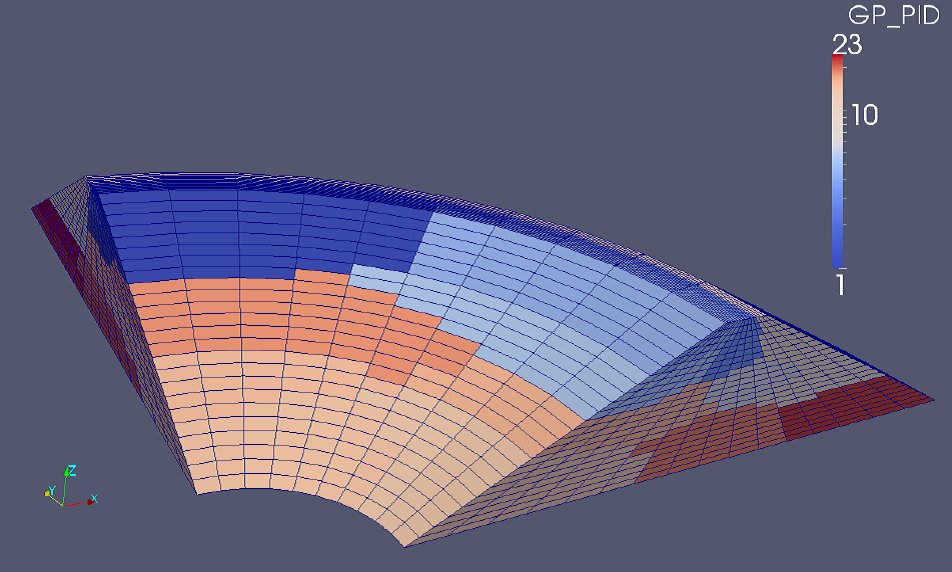Xin MA
Large-scale 3D numerical simulations of geotechnical problems involving multi-phase soil models
2015
- Kurzfassung auf Deutsch
Abstract
In the present work, a multi-phase model for partially saturated soils is implemented into the open-source FE-program OpenSees [76]. The code is employed on a high performance cluster system, the efficiency of the program is optimized and tested by a numerical study focussing on numerical simulations of geotechnical problems.
In the context of the multi-phase formulation, a modified constitutive model for partially saturated soils is applied, which was originally proposed in [50]. It is formulated in terms of two independent stress variables, i.e. generalized e.ective stress and matric suction. It was applied successfully to the numerical simulation of the behavior of unsaturated (silty) sands. The latter model is improved in several respects aiming at an enhanced robustness at the transition from unsaturated to saturated states and at an extension of the range of application from sands to low and medium plasticity clays.
The nonlinear system of equations arising from the finite element formulation of the multi-phase model is solved by a Newton-type approach. It is extended by a relaxation strategy to limit the per-step increment in matric suction and by a line search along the directions provided by the consistent tangent moduli. For solving the linear system of equations resulting from the Newton-type approach at the structural level the multi-frontal massively parallel sparse direct solver MUMPS [61] is employed.
Furthermore, the implemented three-phase model is applied to the numerical simulation of two geotechnical problems. At first, a transient 3D simulation of water flow through an earth dam is performed. Secondly, a well pumping test, which was conducted in the urban area of Tianjin, is simulated numerically employing both two and three dimensional discretizations. The ability of the numerical model to predict the settlements in the vicinity of the well and the fluid flow through the soil is demonstrated.
Finally, large-scale 3D numerical simulations are performed on two different HPC (High Performance Computing) cluster architectures, i.e. the shared memory machine MACH [41] and the distributed memory machines Leo II [39] and Leo III [40] (cf. figure). The latter is the latest supercomputer available at the University of Innsbruck. It consists of 162 compute nodes with a total of 1944 cores. The performance of the program is measured by a group of indicators, e.g. speedup, efficiency and scaling.

Partitioning of a 3D FE model of a dam
In der vorliegenden Arbeit wird ein Mehr-Phasen Modell für teilgesättigte Böden in das Open-Source FE-Programm OpenSees [76] implementiert. Der Code wird auf einem Hochleistungsrechnersystem eingesetzt, die Effizienz des Programms wird optimiert und durch eine numerische Studie mit Schwerpunkt auf numerischen Simulationen von geotechnischen Problemen getestet.
Im Rahmen der Mehr-Phasen Formulierung wird ein modifiziertes konstitutives Modell zur Beschreibung teilgesättigter Böden, das ursprünglich in [50] vorgestellt wurde, angewendet. Es ist in Abhängigkeit von zwei unabhängigen Spannungsvariablen formuliert, nämlich den verallgemeinerten effektiven Spannungen und der Kapillarspannung. Es wurde erfolgreich zur numerischen Simulation des Verhaltens von ungesättigten (schluffigen) sandigen Böden eingesetzt. Dieses konstitutive Modell wurde in mehrfacher Hinsicht verbessert, mit dem Ziel einer verbesserten Stabilität beim Übergang von ungesättigten zu gesättigten Zuständen und der Erweiterung des Einsatzbereiches von sandigen Böden auf Tone niedriger und mittlerer Plastizität.
Das nichtlineare System von Gleichungen, das sich aus der Finite Elemente Formulierung des Mehr-Phasen Modells ergibt, wird mittels des Newton Verfahrens unter Verwendung der konsistenten Tangentenmoduli gelöst. Das Newton Verfahren wird durch ein Relaxationsverfahren und durch einen Line-search Algorithmus entlang der durch die konsistenten Tangentenmoduli vorgegebenen Richtungen erweitert. Zur Lösung des linearen Gleichungssystems im Rahmen der Newton Iteration auf der Strukturebene wird der massiv parallele direkte Mehrfrontenlöser MUMPS [61] eingesetzt.
Das implementierte Mehr-Phasen Modell wird für die numerische Simulation von zwei geotechnischen Problemstellungen eingesetzt. Neben einer 3D Simulation der transienten Strömung von Wasser durch einen homogenen Erddamm wird ein Pumpversuch für einen Brunnen im Stadtgebiet von Tianjin sowohl mit einer zweidimensionalen als auch einer dreidimensionalen Diskretisierung nachgerechnet und die Anwendbarkeit dieses numerischen Modells zur Prognose der Setzungen in der Umgebung des Brunnens und der Wasserströmung im Boden demonstriert.
Schließlich werden große 3D Simulationen auf zwei verschiedenen HPC (High Performance Computing) Cluster-Architekturen, nämlich dem Shared Memory System MACH [41] und den Distributed Memory Systemen Leo II [39] und Leo III [40] ausgeführt (siehe Abbildung). Letzteres System ist der derzeit neueste Supercomputer an der Universität Innsbruck. Er besteht aus 162 Knoten mit insgesamt 1944 Kernen. Die Leistungsfähigkeit des Programmes wird durch eine Reihe von Indikatoren, wie speed-up, Effizienz und Skalierung, gemessen.
